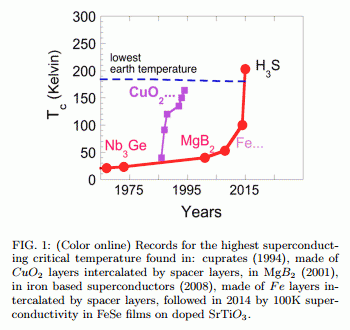The world of superconductivity is in uproar. Last year, Mikhail Eremets and a couple of pals from the Max Planck Institute for Chemistry in Mainz, Germany, made the extraordinary claim that they had seen hydrogen sulphide superconducting at −70 °C. That’s some 20 degrees hotter than any other material—a huge increase over the current record.
Eremets and co have worked hard to conjure up the final pieces of conclusive evidence. A few weeks ago, their paper was finally published in the peer reviewed journal Nature, giving it the rubber stamp of respectability that mainstream physics requires. Suddenly, superconductivity is back in the headlines.
Today, Antonio Bianconi and Thomas Jarlborg at the Rome International Center for Materials Science Superstripes in Italy provide a review of this exciting field. These guys give an overview of Eremet and co’s discovery and a treatment of the theoretical work that attempts to explain it.
